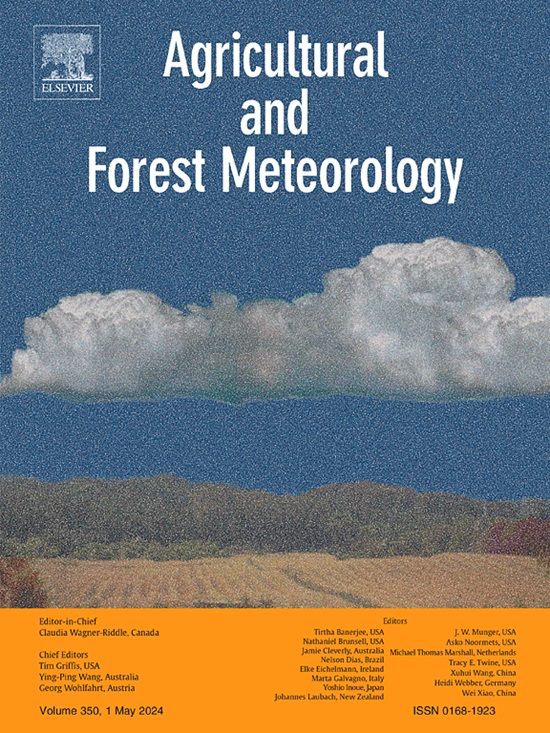Spatiotemporal variation of forest water conservation based on dual-variable calibration of runoff and evapotranspiration with SWAT model
IF 5.7
1区 农林科学
Q1 AGRONOMY
引用次数: 0
Abstract
To address the limitations of traditional Soil and Water Assessment Tool (SWAT) model calibration that relies solely on runoff, which fails to accurately depict the water cycle process and reasonably quantify forest water conservation, we proposed an improved approach. This method firstly conducts regional adaptation assessment and correction of evapotranspiration (ET) products based on water balance principles, then develops a dual-variable calibrated SWAT model using observed runoff and corrected products ET to obtain more accurate forest water conservation. Application of this method in Shanmei Reservoir Watershed (SMRW) located in southeastern coast of China demonstrated following results. Firstly, when the length of time series used for water balance analysis exceeded or equal to 11 years, the multi-year average change of water storage in the watershed could be negligible. Compared with the water-balance ET, the relative error of three ET products after correction were <1 %. It indicated that the ET products correction method was workable. Secondly, the SWAT model with dual-variable calibration improved the simulation performance of daily runoff and spatiotemporal variations of ET. However, the degree of improvement varied across different products. The corrected FLDAS ET exhibited the best model application performance and the most significant improvement effect in the SMRW. Thirdly, the multi-year average amount of forest water conservation and forest water conservation coefficient from 2005–2016 in the SMRW were 574.05 mm and 0.31, respectively, and the spatial distribution pattern was high from east to west and low in the middle. Precipitation and forested land area were important factors affecting forest water conservation. Based on the correction of ET product, the SWAT model with dual-variable calibration can reflect spatiotemporal variations of forest water conservation more reasonably.
基于径流和蒸散双变量定标SWAT模型的森林保水时空变化
针对传统水土评价工具(SWAT)模型仅依赖径流进行定标,无法准确描述水循环过程,无法合理量化森林水土保持的局限性,提出了一种改进方法。该方法首先基于水分平衡原理对蒸散发(ET)产品进行区域适应性评估和校正,然后利用实测径流和校正后的蒸散发产品建立双变量校准SWAT模型,以获得更精确的森林保水能力。该方法在中国东南沿海山美水库流域的应用结果表明:首先,当用于水平衡分析的时间序列长度大于等于11年时,流域多年平均储水量变化可以忽略不计。与水平衡蒸散发相比,校正后3种蒸散发产品的相对误差为1%。结果表明,ET产品校正方法是可行的。双变量定标SWAT模型提高了日径流量和蒸散发时空变化的模拟性能,但不同产品的改善程度不同。修正后的FLDAS ET在SMRW中表现出最好的模型应用性能和最显著的改善效果。③2005-2016年小流域多年平均森林保水量和森林保水系数分别为574.05 mm和0.31 mm,空间分布格局呈现自东向西高、中部低的格局。降水量和林地面积是影响森林涵养水分的重要因素。在对ET产品进行校正的基础上,双变量定标SWAT模型能更合理地反映森林保水的时空变化。
本文章由计算机程序翻译,如有差异,请以英文原文为准。
求助全文
约1分钟内获得全文
求助全文
来源期刊
CiteScore
10.30
自引率
9.70%
发文量
415
审稿时长
69 days
期刊介绍:
Agricultural and Forest Meteorology is an international journal for the publication of original articles and reviews on the inter-relationship between meteorology, agriculture, forestry, and natural ecosystems. Emphasis is on basic and applied scientific research relevant to practical problems in the field of plant and soil sciences, ecology and biogeochemistry as affected by weather as well as climate variability and change. Theoretical models should be tested against experimental data. Articles must appeal to an international audience. Special issues devoted to single topics are also published.
Typical topics include canopy micrometeorology (e.g. canopy radiation transfer, turbulence near the ground, evapotranspiration, energy balance, fluxes of trace gases), micrometeorological instrumentation (e.g., sensors for trace gases, flux measurement instruments, radiation measurement techniques), aerobiology (e.g. the dispersion of pollen, spores, insects and pesticides), biometeorology (e.g. the effect of weather and climate on plant distribution, crop yield, water-use efficiency, and plant phenology), forest-fire/weather interactions, and feedbacks from vegetation to weather and the climate system.

 求助内容:
求助内容: 应助结果提醒方式:
应助结果提醒方式:


